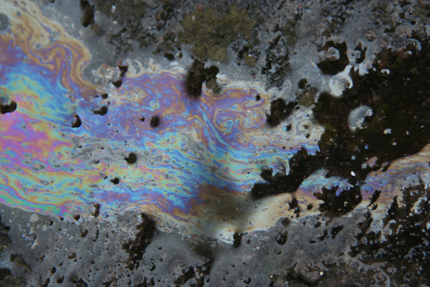sandbox-screen-soil-contamination
The soil testing methods listed on this page use different approaches to screen for contaminants. In general, the data these methods produce are less accurate and precise than certified lab-based methods, but the methods are more accessible in terms of materials, cost, and logistics. Many screening methods are available as kits or portable units that can be used quickly in the field.
Screening for heavy metals and organic compounds
Overviews on Public Lab
How to Test Soil for Oil & Gas Contaminants* please contribute
Post by @DanielleS 5 | almost 6 years ago
Reagent-based PAH, VOH, PCB testing kits for soil and water, with pricing
Post by @warren 0 | almost 11 years ago
Example methods and tools
Hanby Field Test Kit
Image: Learning about the Hanby Field Test Kit at the Houston Barnraising, by @zengirl2
- Tests for: Organic contaminants (petroleum products, PAHs, PCBs)
- Advantages: Tests can be done quickly in the field; relatively low cost per sample.
- Limitations: Can be difficult to compare color if the sample is dark; other petroleum compounds might interfere with color changes and lead to inaccurate results interpretation. See more in this comment by @jjcreedon.
Posts and wikis related to the hanby-soil-kit
| Title | Author | Created | Updated | Likes | Views | Type |
|---|---|---|---|---|---|
| Soil Testing and ATSDR in Pascagoula, MS | @stevie | almost 4 years ago | 0 | 1 | note |
| What do I need to know before collecting soil for the Hanby soil testing kit? | @CherokeeConcernedCitizens | over 4 years ago | 1 | 1 | note |
| Soil Testing at the Houston Barnraising | @DanielleS | about 5 years ago | 2 | 1 | note |
| How to Use a Hanby Kit to Test for Soil Petroleum Hydrocarbons | @DanielleS | almost 6 years ago | 0 | 1 | note |
Nuestros Suelos: a low-cost toolkit for the participative assessment of soil degradation
_23.02.03.png)
Image: Soil testing toolkit by @sureta.
- Tests for: indicators of fertility (organic matter, carbonates, N-P-K, and pH) and presence of heavy metals (copper and arsenic).
Posts and wikis related to nuestros-suelos
| Title | Author | Created | Updated | Likes | Views | Type |
|---|---|---|---|---|---|
| JAM#5: Nuestros suelos | @imvec | over 4 years ago | 1 | 1 | note |
| Nuestros Suelos: a low-cost toolkit for the participative assessment of soil degradation | @sureta | almost 5 years ago | 5 | 1 | note |
Portable X-ray fluorescence (XRF) spectrometer
Image: Portable XRF in the field. USDA photo by Lance Cheung, CC0
- Tests for: Metals.
- Advantages: Tests are relatively non-destructive and can be done quickly in the field with portable or handheld units; high cost to purchase but options to rent units can lower costs relative to testing via lab analytical techniques.
- Limitations: It might not be sensitive enough to detect metal concentrations that are relatively low but still above regulatory levels for toxicity (from EPA Method 6200 doc).
Posts and wikis related to xrf
| Title | Author | Created | Updated | Likes | Views | Type |
|---|---|---|---|---|---|
| Spectral sensing for metals | @Shannon | over 12 years ago | 2 | 1 | note |
Other methods
- Public Lab community members came up with some ideas for soil testing in response to this question: What are other ways to assess soil contamination, besides directly measuring contaminant concentrations?
- This spreadsheet lists several soil testing methods and tools, including those for screening purposes.
- This paper describes a reagent-based field test to screen for lead in soil: Landes F.C., Paltseva A., Sobolewski J.M., Cheng Z., Ellis T.K., Mailloux B.J., and van Geen A. 2019. A Field Procedure To Screen Soil for Hazardous Lead. Analytical Chemistry, 91: 8192-8198. LINK to PDF.
Measuring effects of contaminants (toxicity)
The screening methods listed above indicate relative or real amounts of a contaminant in a soil sample. But the amount of a contaminant in the soil doesn’t always translate into a predictable effect on living things. To learn about the potential for harmful impacts from contaminated soil, some people complement typical soil testing with tests for toxicity or “effect-based” tests.
Image: An example “effect-based test” is a bioassay. This image is of a lettuce seed bioassay showing longer roots in lettuce seeds that sprouted in distilled water (DW) compared to shorter roots in seeds exposed to different concentrations of ethyl acetate, a chemical that negatively affects growth. From Waqas et al. 2013, CC BY
Methods related to effect-based-test will appear here
Questions about soil testing for screening purposes
Questions tagged with question:screen-soil-contamination will appear here
| Title | Author | Updated | Likes | Comments |
|---|---|---|---|---|
| Nothing yet on the topic "screen-soil-contamination" -- be the first to post something! |
Activities on soil testing for screening purposes
Activities tagged with activity:screen-soil-contamination will appear here
| Purpose | Category | Status | Author | Time | Difficulty | Replications |
|---|---|---|---|---|---|---|
| How to Use a Hanby Kit to Test for Soil Petroleum Hydrocarbons | - | - | @DanielleS | - | - | 0 replications: Try it » |
Activities should include a materials list, costs and a step-by-step guide to construction with photos. Learn what makes a good activity here.

